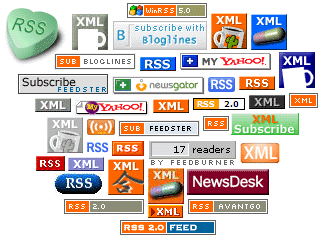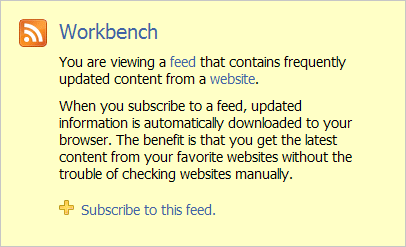The following RSS Advisory Board proposal has been made by Rogers Cadenhead and seconded by Meg Hourihan.
Under the board charter, this begins a seven-day discussion period so any interested parties can comment on the proposal. (The best place to comment is on the mailing list RSS-Public.)
When that ends, the board will have seven days to vote on it.
Proposal
A recent Yahoo study reported that four percent of Internet users have jumped on the RSS bandwagon and begun subscribing to syndicated feeds.
Considering the number of ways that web publishers show their readers they offer feeds, it's amazing we've gotten that many:

In an effort to make the concept of syndication easier for mainstream users, the next versions of the Internet Explorer and Opera browsers will identify RSS and Atom feeds with the same icon used in Mozilla Firefox. Since the market share of these browsers tops 95 percent, the icon will become the de facto standard for syndication overnight when the next version of Microsoft Windows comes out later this year.
The common feed icon has been adopted by hundreds of web sites in the last 60 days. I've been experimenting with it on Workbench and like the results.
In October 2005, Jane Kim of Microsoft's Internet Explorer team explained what they were looking for when selecting a feed icon for the browser:
- It conveys the important attributes of feeds: newness, activity, subscription, and continual information.
- It builds on the most consistent and identifiable element used to represent feeds today: the orange rectangle.
- It avoids the use of text. Icons that have text do not generally work well for a global audience. For example, an icon with the text "FEED" may be cryptic to users whose primary language is non-Latin based. Text is very important to support an icon (in tool-tips or accompanying text). In English, we will be using the verb "subscribe" fairly widely whenever text is appropriate.
Microsoft ultimately chose Stephan Horlander's Firefox icon -- with permission -- and will use it in all of its software.
The RSS Advisory Board should officially support the common feed icon, adopting the symbol on its own site and encouraging its use on web sites, browsers, and syndication software.
Additionally, the board should encourage web publishers to use the icon on any feed, regardless of whether it employs Atom or the two formats that call themselves RSS: RDF Site Summary and Really Simple Syndication.
As technology reaches mass adoption, the technical details fade into the background. This is already beginning to happen with syndication, in spite of several years of "tastes great/less filling" between advocates of different formats.
In Internet Explorer 7, two words are completely absent from all places where Microsoft tells users how to read their favorite web sites using syndication -- RSS and Atom:

The benefits of syndication are still a hard sell for non-technical people, seven years after Dan Libby of Netscape published the first format called RSS. The use of a common icon and jargon-free language like "subscribe to a feed" have the potential to make things considerably easier.